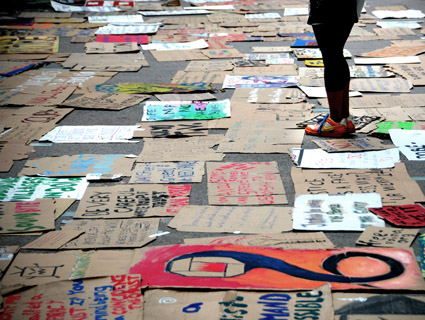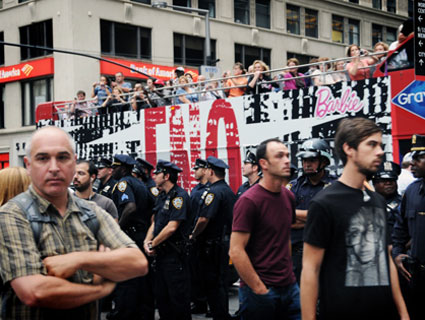UPDATE: By the weekend of October 15th, the Zuccotti campers had adopted this new plan for the park and reorganized themselves accordingly.
As the Occupy Wall Street movement has caught fire over the past week, reporters and pundits keep asking whether the occupiers can unite around a common goal. Will they tackle income inequality, corporate control of politics, Wall Street reforms? Maybe. But the first order of business is much more basic: figuring out how to organize and maintain their impromptu campground.
Prosaic as it may seem, getting a handle on the chaos in Zuccotti Park is an important test case for whether the disparate voices of Occupy Wall Street can work together. For more than two weeks, protest leaders collaborated with city planners, urban geographers, and technology whizzes to create a new, detailed urban plan for the park, with an eye toward safety, public relations, and traffic flow.
The collaborators included Jake DeGroot, a techie with experience creating computerized stage and concessions layouts for concert and event planners; Mike Esperson, a former Haiti relief worker who has worked in refugee camps; Daniel London, a doctoral student in history at City University of New York who obtained the original architectural plan for the park; and Katie Gill, a geographer with training in city planning who specializes in how people navigate urban spaces.
Their plan is an attempt to make Zuccotti Park cleaner, more welcoming, and ultimately more likely to endure as the nexus of a national protest movement. As historian London puts it: “Just like Boston was the ‘City on the Hill’ in its own time, right now the eyes of the world are on Zuccotti Park, and we need to create a space that will inspire them as well as serve our own needs.” Here’s an interactive map of the proposal, which park residents may vote on next week. Click an area of the map to see what’s planned there. Map image source: Courtesy Occupy Wall Street Planning Group Members.















